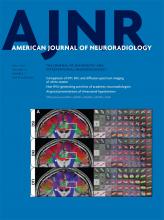Research ArticleNeurointervention
Inflow Jet Patterns of Unruptured Cerebral Aneurysms Based on the Flow Velocity in the Parent Artery: Evaluation Using 4D Flow MRI
K. Futami, T. Kitabayashi, H. Sano, K. Misaki, N. Uchiyama, F. Ueda and M. Nakada
American Journal of Neuroradiology July 2016, 37 (7) 1318-1323; DOI: https://doi.org/10.3174/ajnr.A4704
K. Futami
aFrom the Department of Neurosurgery, Mattoh-Ishikawa Central Hospital (K.F.), Ishikawa, Japan
T. Kitabayashi
bDepartments of Neurosurgery (T.K., H.S., K.M., N.U., M.N.)
H. Sano
bDepartments of Neurosurgery (T.K., H.S., K.M., N.U., M.N.)
K. Misaki
bDepartments of Neurosurgery (T.K., H.S., K.M., N.U., M.N.)
N. Uchiyama
bDepartments of Neurosurgery (T.K., H.S., K.M., N.U., M.N.)
F. Ueda
cRadiology (F.U.), Kanazawa University School of Medicine, Ishikawa, Japan.
M. Nakada
bDepartments of Neurosurgery (T.K., H.S., K.M., N.U., M.N.)

REFERENCES
- 1.↵
- 2.↵
- Neugebauer M,
- Gasteiger R,
- Janiga G, et al
- 3.↵
- Cebral JR,
- Sheridan M,
- Putman CM
- 4.↵
- Cebral JR,
- Castro MA,
- Burgess JE, et al
- 5.↵
- Cebral JR,
- Mut F,
- Weir J, et al
- 6.↵
- Castro MA,
- Putman CM,
- Sheridan MJ, et al
- 7.↵
- Schneiders JJ,
- Marquering HA,
- Antiga L, et al
- 8.↵
- Jansen IG,
- Schneiders JJ,
- Potters WV, et al
- 9.↵
- Meckel S,
- Stalder AF,
- Santini F, et al
- 10.↵
- Boussel L,
- Rayz V,
- Martin A, et al
- 11.↵
- 12.↵
- Isoda H,
- Ohkura Y,
- Kosugi T, et al
- 13.↵
- Isoda H,
- Ohkura Y,
- Kosugi T, et al
- 14.↵
- 15.↵
- Kawaguchi T,
- Nishimura S,
- Kanamori M, et al
- 16.↵
- 17.↵
- van Ooij P,
- Schneiders JJ,
- Marquering HA, et al
- 18.↵
- 19.↵
- 20.↵
- Futami K,
- Sano H,
- Misaki K, et al
- 21.↵
- Futami K,
- Sano H,
- Kitabayashi T, et al
- 22.↵
- Hollnagel DI,
- Summers PE,
- Poulikakos D, et al
- 23.↵
- Lorensen WE,
- Cline HE
- 24.↵
- Shimai H,
- Yokota H,
- Nakamura S, et al
- 25.↵
- 26.↵
- 27.↵
- 28.↵
- 29.↵
- Xiang J,
- Yu J,
- Snyder KV, et al
- 30.↵
- 31.↵
- Tang C,
- Blatter CC,
- Paker DL
In this issue
American Journal of Neuroradiology
Vol. 37, Issue 7
1 Jul 2016
Advertisement
K. Futami, T. Kitabayashi, H. Sano, K. Misaki, N. Uchiyama, F. Ueda, M. Nakada
Inflow Jet Patterns of Unruptured Cerebral Aneurysms Based on the Flow Velocity in the Parent Artery: Evaluation Using 4D Flow MRI
American Journal of Neuroradiology Jul 2016, 37 (7) 1318-1323; DOI: 10.3174/ajnr.A4704
0 Responses
Jump to section
Related Articles
- No related articles found.
Cited By...
This article has not yet been cited by articles in journals that are participating in Crossref Cited-by Linking.
More in this TOC Section
Similar Articles
Advertisement











